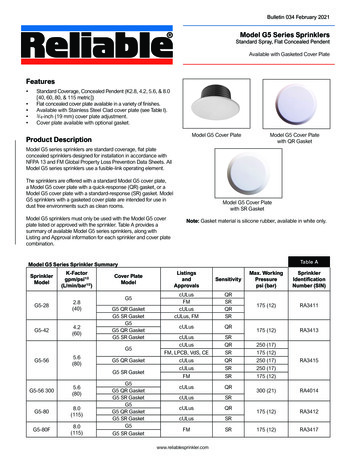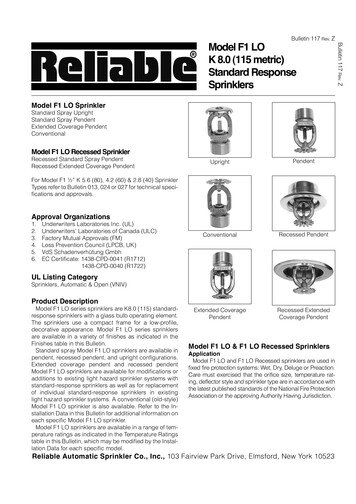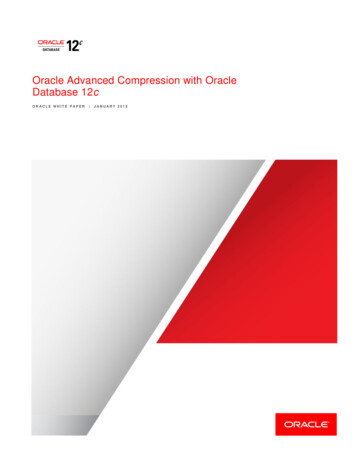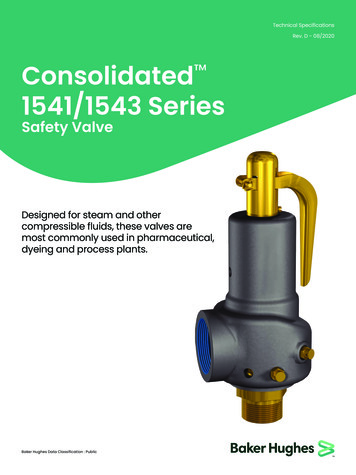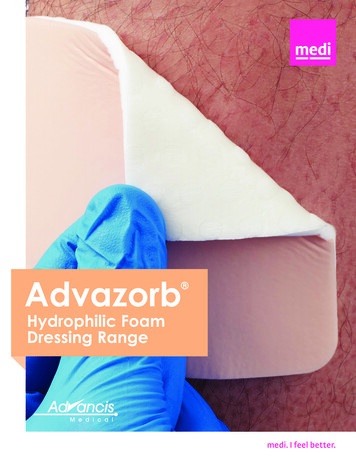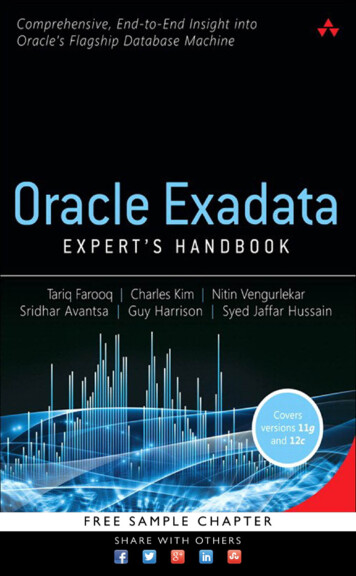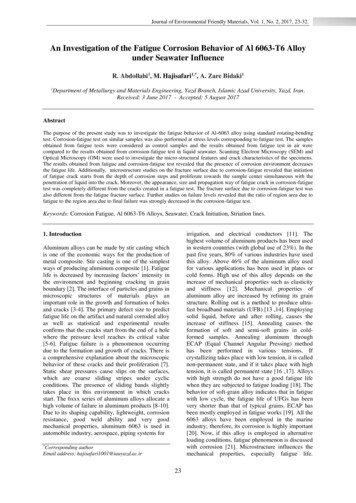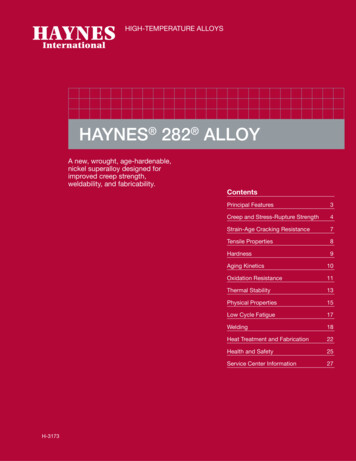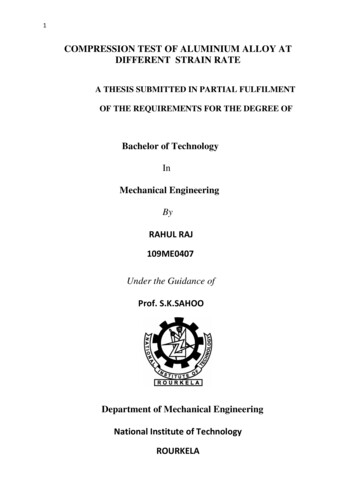
Transcription
1COMPRESSION TEST OF ALUMINIUM ALLOY ATDIFFERENT STRAIN RATEA THESIS SUBMITTED IN PARTIAL FULFILMENTOF THE REQUIREMENTS FOR THE DEGREE OFBachelor of TechnologyInMechanical EngineeringByRAHUL RAJ109ME0407Under the Guidance ofProf. S.K.SAHOODepartment of Mechanical EngineeringNational Institute of TechnologyROURKELA
2National Institute of TechnologyROURKELACERTIFICATEThis is to certify that thesis entitled, “COMPRESSION TEST OF ALUMINIUMALLOY AT DIFFERENT STRAIN RATE” submitted by RAHUL RAJ in partialfulfilment of the requirements for the award of Bachelor of Technology Degreein Mechanical Engineering at National Institute of Technology Rourkela is anauthentic work carried out by him under my Supervision and guidance. To thebest of my knowledge, the matter included in this thesis has not been submittedto any other university or institute for award of any Degree.Date: 10th may, 2013Prof. S.K.SAHOODept. of Mechanical EngineeringNational Institute of TechnologyRourkela- 769008
3ACKNOWLEDGEMENTI express my deep sense of gratitude and indebtedness to my project guide ProfS.K.Sahoo, Department of Mechanical Engineering, NIT Rourkela forintroducing the topic and for his best guidance, consistent encouragement andconstant supervision throughout the course of this work.I would like to give special thanks to Mr. srikar, PG scholar in mechanicalengineering who gave his valuable time and support for this project work.I also express my sincere gratitude to Mr. Susant Sahu PG Scholars inMechanical Engineering for giving their valuable time.I am grateful to Prof. K.P.Maity, Head of the Department of MechanicalEngineering for providing me the necessary facilities in the department.Date: 10th may, 2013RAHUL RAJ109ME0407Dept. of Mechanical Engineering.
4ABSTRACTCompression test of aluminium alloy at different strain rate wereexperiments carried out on a universal testing machine at roomtemperature and under a different strain rate ranging from 0.01/s to0.15/s using powdered graphite mixed with machine oil as lubricantall over the tests. True Stress and strain values were calculated usingthe engineering equation which was used to plot the true stress-straincurve for different strain rate, which indicates the mechanicalproperties of the metal for industrial applications.Keywords: Compression, True Stress, True Strain, RegressionAnalysis
5CONTENTAbstract. 4Chapter 11. Introduction. 7-91.1 compression test.71.2 Effect of different parameters on compression .81.3 Material used .8Chapter 22. LiteratureReviews.10-11Chapter 33. Experimental Details .12-163.1 Experimental Setup .123.2 specimen preparation.143.2 Graphite as lubricant.153.4 Description.16
6Chapter 44. Result and discussion 174.1 flow curve . .17-254.2 Non-linear least square Regression analysis.25Chapter 55.1 conclusion . .27Reference . .28
7Chapter 1Introduction1. INTRODUCTION1.1 Compression TestA compression test determines the characteristics of materials under crushingloads. The sample is compressed and deformation at various loads is noted.Compressive stress and strain was calculated and plotted as a stress-straindiagram which is used to determine elastic limit, proportional limit, yieldstrength and yield point. Compression Tests are of extremely high importance,because it helps to calculate the different material properties that are applicableto hot as well as cold metal forging employed for different metal formingapplications. It becomes important to find the suitable load to carry out theoperations. Load depends on the materials and flow stress. Flow behaviour ofaluminium at different strain rate can be determined by establishing arelationship between flow stress, strain and strain rate. When a compressiveload is applied on a specimen, the deformation may take place: for brittlematerials it may be crushing or fracture and for ductile material it may be due toelastic or plastic.1.2 Effect of Different Parameters on CompressionEffect of strain rateThe rate at which strain is applied to a specimen can have an importantinfluence on the flow stress. Strain rate is defined as:strain rateIt is expressed in units of /sec. normally, increasing strain rate increases flowstress.
81.3 MaterialAluminiumisa chemicalelement inthe borongroup withsymbol Al and atomic number is 13. It is silvery white, and it is not soluble inwater. After oxygen and silicon, aluminium is the third most abundant elementin the Earth's crust. Aluminium has a unique combination of attractiveproperties. high strength, Low weight, great malleability, easy machining,excellent corrosion resistance and good thermal and electrical conductivity areamongst aluminium’s most significant properties. Aluminium is also very easyto recycle. The chief ore of aluminium is bauxite. It is nonmagnetic and doesnot easily ignite. Commercial purity of aluminium is 99.5 to 99.79%, but purealuminium is too soft to be of structural value. The primary reason for alloyingaluminium is to increase strength without increasing weight and reasons are toimprove weldability, machinability, surface appearance and corrosion,resistance. The main alloying elements are magnesium, manganese, copper,silicon and zinc.Different Properties of AluminiumAluminium is unique and unbeatable combination of properties making its useversatile. It is highly usable and attractive construction material.Weight: Al is the light material compare to other material like steel. Its Densityis 2.700 kg/m3Strength: Aluminium is strong with the tensile strength 70 to 700 MPa. Itsstrength depends on the alloying materials and manufacture process.Linear expansion: Aluminium has a relatively large coefficient of linearexpansion.Elasticity: The Young’s modulus of Al is one-third of steel (E 70,000 MPa).Formability: Aluminium has a good formability. With the hot metal or coldmetal this property is exploited in the rolling of strips and foils.Machinability: Aluminium is very simple to machine. Aluminium is suitablefor forming in both hot and cold process.Joining: Aluminium can be joined applying all the methods available as thewelding, soldering, adhesive bonding and riveting.Reflectivity: Aluminium is a best reflector of both visible light and heat.
9Corrosion resistance: Aluminium generates a protective oxide coating and ishighly corrosion resistant. It is useful for application where protection andconservation are required.Conductivity: Al is an excellent conductor of heat and electricity. Al conductoris only half the weight of an equivalent Cu conductor.Non-toxic: Aluminium is not poisonous; that’s why it is highly suitable for thepreparing and storage of the meal.Non-magnetic material: Aluminium is a non-magnetic material. Al is used inmagnet X-ray devices to avoid the interference of magnetic fields.Different Applications of Aluminium:Aluminium alloy are wide range of application. Followings application aresome of them.I. In aircraft and other aerospace structureII. for boat and shipbuilding, and other marine and salt-water sensitive shoreapplicationsIII. for cycling frames and componentsIV. for automotive body panelsV. As packaging materials.VI. In making household components etc.
10CHAPTER 2LITERATURE SURVEYLiterature SurveyBecause of many use of aluminium in electrical conductors, air conditioningunits, optical and light reflectors the strain rate behaviour of aluminium is needto know. Out of them some important literatures are discussed here:At small strain rate the true stress–true strain curves exhibit a peak stress afterthat the flow stresses decrease monotonically until high strains. The stressdecreases with increasing deformation temperature and decreasing strain rate[1].The deformed structures demonstrate elongated grains with serrationsdeveloped in the grain boundaries dynamic recovery and recrystallization arethe main reasons for the flow softening [2].Investigation showed that when the peak stress level increased then strain ratedecrease. The geometrical dynamic recrystallization Occurred at temperaturesbelow 520 [3].The stress level decreases with increasing temperature and decreasing strainrate, which can be represented by the Zener–Hollomon parameter Z in thehyperbolic sine equation [4].The homogenized aluminium alloy when temperature increased or the strainrate decreased. The main softening mechanism of 7050 aluminum alloy isdynamic recovery [5].The strain has shown an effect on the material constants, and true stress–truestrain curves have showed that the flow stress was sensitive to the deformationstrain rate and temperature for the 7050 aluminium alloy [6].
11The flow stress increases with increasing the strain rate or decreasing thedeformation temperature, which can be described by a hyperbolic-sineconstitutive equation [7].When the z value decrease the main softening mechanism of the al alloytransforms from dynamic recovery to dynamic recrystallization. And thesubgrain size increase and the dislocation density decrease [8].
12CHAPTER-3Experimental DetailsExperiment details3.1 Experimental SetupThe experiments were carried out in the universal testing machine ofINSTRON SATEC 600 KN. 600 KN Models of INSTRON are idealfor high capacity tension, compression, flex and shear testing. Thisdesign offers the ultimate versatility by accommodating a largevariety of specimen sizes, grips, fixtures and extensometers. Thesemodels feature an ultra large, single test space and so user friendly(easily and safely) load and unload specimens. Models include:300KN, and 600KN, 1200KN, 1500KN, 2000KN and 3500KTable 3.2 Specifications of INSTRON SATEC 600 KNmakerSoftwaretypeMax. Loading capacityMax. Vertical test openingActuator strokeLoad accuracyStrain accuracyInstron,UKBluehill EM Consolehydraulic600 KN1625 mm508 mm 0.5% of reading down to 1/500 ofLoad cell capacity 0.5 of reading down to 1/50 ofFull range
13Figure 3.1 INSTRON SATEC
14Figure 3.2 temperature controller3.3 Preparation of sampleCompression Test to be conducted requires the testing of 15Specimens prepared from the raw aluminium rod.Specimen Specifications:L/Deff1.6 for to assure a geometrical dimensional factor andhomogeneous deformationL Length of the Specimen
15Deff Effective Diameter of the Cross Section of the SpecimenHence if Deff 10 mm, L should be approximately 15 mmIn the current experiment, L has been taken as 18 mmSpecimens of the required dimensions were cut from the aluminiumAlloy bar using hacksaw and facing operation was carried out toMake the two ends parallel by the lathe machine.3.4 Graphite use as a lubricant:Graphite powder and machine oil in a proper ratio were mixedproperly to form the lubricant for the test. Graphite is one of theallotropes of carbon. Graphite has one carbon atom covalently bondedto three other carbon atoms, forming a hexagonal molecular structurewith layers held by weak Van der Waal forces. As the Van der Waalsforces between the layers are less strong, the layers can easily slideover each other. Thus, it can be used as a lubricant. The distance ofcarbon atoms between planes is longer and therefore the bonding isweaker. Graphite is best for lubrication in a regular atmosphere.Graphite mainly classified into two main categories that is natural andsynthetic. Natural Graphite is a generally mineral consisting ofgraphitic carbon. Natural graphite is an excellent conductor of heatand electricity. It is stable for a wide range of temperatures. Syntheticgraphite can be produced from coke and pitch. Graphite as a lubricantis used as dry powder or mixed with water or oil. When mixed withwater, it is called 'aqua-dag' and when mixed with oil, it is called 'oildag'.Graphite lubrication is taken so that the specimen does not get forgedto the anvil and ram at high temperature.
163.5 DescriptionAfter applying graphite lubricant coating on both the sides of thespecimens, they are placed in between the top and bottom plate of thesetup such that the axis of the specimen is concentric with the axis ofthe ram. Then the hydraulic load is applied on the test specimen andtest is carried out at room temperature. For each test, one specimenwas taken and deformed to different strain rates. The loads usedduring each deformation were recorded automatically by theBLUEHILL software incorporated with the UTM machine.Compressive test was carried out by giving a deformation of 10 mm,at fifteen strain rate from 0.01/s to 0.15/s. At the end of eachexperiment time taken (sec), compressive extension (mm),compressive load (N), compressive stress (Pa), compressive strain(%), true stress (Pa) and true strain (%) were recorded automaticallyin the database of the computer(system), which was further used bythe software to generate True stress vs. True strain graph.
17Chapter 4Results and Discussions4.1 Result and DiscussionTrue stress and true strain curves obtained during compression ofaluminium alloy at a strain rate of 0.01 to 0.15/s. The peak stress andflow stress increase with increasing strain rate. If the true stress basedon the actual cross-sectional area of the specimen is used, it is foundthat stress-strain curve increases continuously until plasticdeformation occurs. If the strain measurement is also based oninstantaneous measurement, the curve is called true stress-straincurve. Many attempts have been made to fit mathematical equationsto this curve. The most common is a power expression of in the formσ AWhere, σ true stress, A is strength coefficient, n is the strainhardening exponent.BLUEHILL software incorporated with the UTM machineautomatically generates the flow curve for each specimen
18instantaneously after the experiment using the true stress and truestrain data saved in computer’s database. It uses the engineeringequation to generate the flow curves.Flow curve FOR STRAIN RATE 0.01/SSpecimen-1true stres(N/mm 2)25020015010050000.20.40.60.811.21.41.61.82true strain(mm/mm)Figure 4.1 Variation of true stress with true strain at 0.01 strain rate
19 For strain rate 0.02/strue stress(N/mm 2)specimen- true strain (mm/mm)Figure 4.2 Variation of true stress with true strain at 0.02 strain rate For strain rate 0.03/sspecimen -3true stress(N/mm ue strain(mm/mm)Figure 4.3 Variation of true stress with true strain at 0.03 strain rate
20 For strain rate 0.04/sspecimen -4250true stress(N/mm 2)200150100500-0.500.5-5011.52true strain(mm/mm)Figure 4.4 Variation of true stress with true strain at 0.04 strain rate For strain rate 0.05/sspecimen- 5250true stress(N/mm 2)2001501005000-500.511.522.5true strain(mm/mm)Figure 4.5 Variation of true stress with true strain at 0.05 strain rate
21 For strain rate 0.06/sFigure 4.6 Variation of true stress with true strain at 0.06 strain rate For strain rate 0.07/sspecimen- 7250true stress(N/mm 2)200150100500-0.50-500.51true strain(mm/mm)1.52
22Figure 4.7 Variation of true stress with true strain at 0.07 strain rate For strain rate 0.08/sspecimen -8250true stress (N/mm 2)200150100500-0.500.5-5011.52true strain(mm/mm)Figure 4.8 Variation of true stress with true strain at 0.08 strain rate For strain rate 0.09/sspecimen -9250true stress(N/mm 2)2001501005000-500.20.40.60.811.21.41.61.82true strain(mm/mm)Figure 4.9 Variation of true stress with true strain at 0.09 strain rate
23 For strain rate 0.10/sspecimen -10250true stress (N/mm 2)200150100500-0.500.5-5011.522.5true strain(mm/mm)Figure 4.10 Variation of true stress with true strain at 0.10 strain rate For strain rate 0.11/sspecimen -11250true stress(N/mm 2)200150100500-0.50-500.511.52true strain(mm/mm)Figure 4.11 Variation of true stress with true strain at 0.11 strain rate
24 For strain rate 0.12/sspecimen-12true stress(N/mm 2)25020015010050000.511.522.5true strain(mm/mm)Figure 4.12 Variation of true stress with true strain at 0.12 strain rate For strain rate 0.13/sspecimen -13true stress (N/mm 2)250200150100500-0.50-500.511.522.5true strain(mm/mm)Figure 4.13 Variation of true stress with true strain at 0.13 strain rate
25 For strain rate 0.14/sspecimen -14true stress(N/mm 2)200150100500-0.500.5-5011.522.5true strain(mm/mm)Figure 4.14 Variation of true stress with true strain at 0.14 strain rate For strain rate 0.15/sspecimen 15true stress(N/mm 2)250200150100500-0.500.511.522.5true strain(mm/mm)Figure 4.15 Variation of true stress with true strain at 0.15 strain rate
264.2 Linear regression analysisRegression analysis is used for modelling and analysing variables,which demonstrate mathematical relationship between a dependentvariable and one or more independent variables. A large no oftechniques have been developed for carrying out regression analysis.Out of all those, linear regression and least squares regression aremore commonly used. Least squares problems fall into twocategories: linear least squares and non-linear least squares. Themain difference between these two is linear least square has aclosed-form solution whereas the nonlinear has no closed-formsolution.The purpose of using Regression Analysis is to produce amathematical relationship between true stress and true strain, whichwill define the flow stress behaviour of the material. The mostcommon is a power expression of the forṁ CThis equation represents the straight line y mx c, whichcan be used to find the maximum stress at different value of strainrate.
27300max. true stress(N/mm 0.09strain rate(/s)Graph should be linear but due to less accuracy graph is nonlinear.̇ C()()After solving equation
28Chapter-5ConclusionFollowing conclusions were obtained from results: True stress decreases with decreasing true strain. Strain hardening component depends on the stress and strain Increase of stress with strain rate can be represented by thelinear equation 1388.9 ̇ 134.2 for the present aluminiummaterial. The increase of stress with strain rate is found to be erratic. Itmay be due to the experimental error.
29REFERENCES[1]. Hui Zhang, Luoxing Li, Deng Yuan, Dashu Peng Hui Zhang, Luoxing Li,Deng Yuan and Dashu Peng, “Hot deformation behavior of the new Al–Mg–SiCu aluminium alloy during compression at elevated temperatures”, MaterialsCharacterization 58, (2007), pp. 168–173.2. Nengping Jin, Hui Zhang, Yi Han, Wenxiang Wu, and Jianghua Chen, “Hotdeformation behavior of 7150 aluminium alloy during compression at elevatedtemperature”, Materials characterization 60 (2009), pp. 530-536.3. M.R. Rokni, A. Zarei-Hanzaki, Ali A. Roostaei ,and H.R. Abedi, “Aninvestigation into the hot deformation characteristics of 7075 aluminum alloy”,Materials and Design 32 (2011),pp. 2339–2344.4. Xudong Huang, Hui Zhang,., Yi Han, Wenxiang Wu,and Jianghua Chen,“Hot deformation behavior of 2026 aluminum alloy during compression atElevated temperature”, Materials Science and Engineering a 527 (2010),pp.485–490.5. Ying Deng, Zhimin Yin, and Jiwu Huang, “Hot deformation behavior andmicrostructural evolution of homogenized 7050 aluminum alloy duringcompression at elevated temperature”, Materials Science and Engineering A528 (2011),pp. 1780–1786.6. Jiang Li, Fuguo Li, Jun Cai, Ruiting Wang, Zhanwei Yuan, and FengmeiXue, “Flow behavior modeling of the 7050 aluminum alloy at elevatedtemperaturesConsidering the compensation of strain”, Materials and Design 42 (2012),pp.369–377.[7] ZHANG Zhi-ye, PAN Qing-lin, ZHOU Jian, LIU Xiao-yan, CHEN Qin,“Hot deformation behavior and microstructural evolution ofAl.Zn.Mg.0.25Sc.Zr alloy during compression at elevated temperatures”.[8] R. Kaibyshev, O. Sitdikov, I. Mazurina, D.R. Lesuer , “Deformationbehavior of a 2219 Al alloy”, Materials Science and Engineering A334 (2002)104–113.
Software Bluehill EM Console type hydraulic Max. Loading capacity 600 KN Max. Vertical test opening 1625 mm Actuator stroke 508 mm Load accuracy 0.5% of reading down to 1/500 of Load cell capacity Strain accuracy 0.5 of reading down to 1/50 of Full range . 13 Figure 3.1 INSTRON SATEC .
